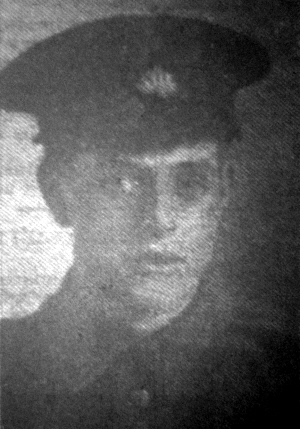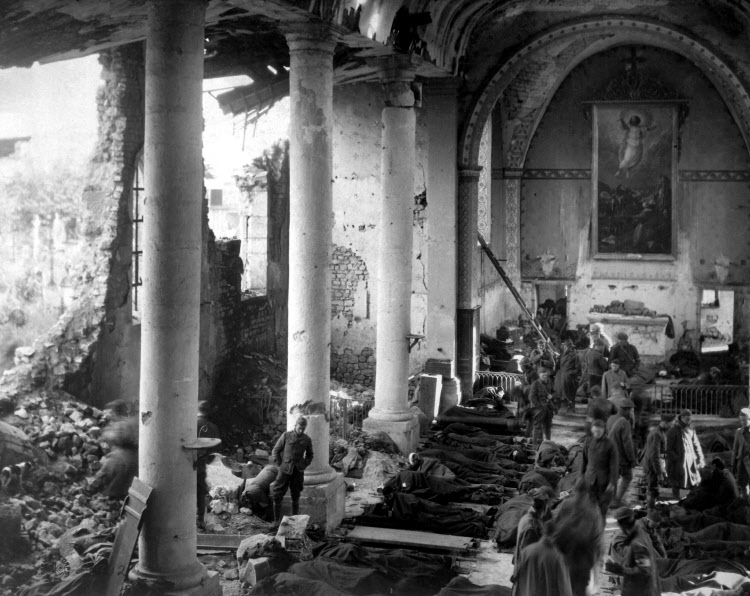 Private George Arthur Shillito, 35019, Duke of Wellington's (West Riding Regiment), 9th Battalion
Private George Arthur Shillito, 35019, Duke of Wellington's (West Riding Regiment), 9th Battalion
George Arthur Shillito was born in Ossett on the 16th September 1899, the son of Darrington born George Shillito and his wife Frances who was born in Ferrybridge. The couple married in 1887 and had three children: William, born 1889, Eliza, born 1890 and George Arthur, born 1899. George Shillito senior, a carrier, and Frances moved to Ossett in about 1889 and settled at Dale Street with two of their children, William and Eliza.
By 1901 the Shillito family, including new born George Arthur, had moved to George Street, Healey Road, Ossett where George senior was working as a teamer in a rag warehouse. By 1911, George, Frances and George Arthur Shillito were living at 41, Westfield Street, Ossett. George Arthur was now aged 11 years of age and at school. His father was a carter for a mungo manufacturer.
George Arthur Shillito of 41, Westfield Street, Ossett was called up and enlisted at Pontefract on the 5th January 1918 and joined the 4th (Reserve) Battalion East Yorkshire Regiment with the service number 38778 and later 82844. He was 18 years and four months of age, 5’ 8½ “ tall, weighed 135 lbs and was working as a mason’s apprentice for Luther Ingham Builders and Contractors of Headlands, Ossett. He named his father as his next-of-kin and specified his religion as Wesleyan.
Private George Arthur Shillito was transferred to the 2/7th Durham Light Infantry on the 11th August 1918 and embarked for France the same day when he was five weeks short of his 19th birthday. On the 30th August 1918, he transferred to the 9th Battalion, Duke of Wellington’s (West Riding Regiment) with service number 35019. George joined them in the field on the 1st September 1918.
Six weeks later, on the 12th October 1918, in a field hospital clearing station, George Arthur died of penetrating gunshot wounds to his abdomen. He was 19 years and 28 days old. His effects were forwarded to his mother, Frances Shillito in March 1919 and comprised letters, photos, wallet, metal cigarette case and cards.
Frances was also required to notify the army of her deceased son’s closest relative and returned the names and addresses of herself and her husband as his parents living at 41, Westfield Street, Ossett. His siblings were also recorded as William Shillito of 45, Westfield Street and Eliza Clarkson (nee Shillito) of 6, Albert Street, Ossett.
Private George Arthur Shillito was posthumously awarded the British and Victory medals.
The 9th (Service) Battalion of the Duke of Wellington's (West Riding Regiment) was raised at Halifax in September 1914 as part of Kitchener's Second New Army and joined 52nd Brigade, 17th (Northern) Division. After initial training close to home, they moved to Wareham, then to Bovington in October and to Wimborne in November 1914. They moved to Hursley Park, Winchester in June 1915 for final training. The division had been selected for Home Defence duties, but this was reversed and they proceeded to France landing at Boulogne on the 15th of July 1915, concentrating near St Omer. They moved into the Southern Ypres salient for trench familiarisation and then took over the the front lines in that area. In the spring of 1916 they were in action at the Bluff, south east of Ypres on the Comines canal then moved south to The Somme seeing action during The Battle of Albert in which the Division captured Fricourt and The Battle of Delville Wood.
In 1917 they moved to Arras and saw action in The First and Second Battles of the Scarpe and The Capture of Roeux. In late summer they moved to Flanders and fought in The First and Second Battles of Passchendaele. In 1918 they were in action in The Battle of St Quentin, The Battle of Bapaume, The Battle of Amiens, The Battle of Albert, The Battle of Bapaume, The Battle of Havrincourt, The Battle of Epehy and The Battle of Cambrai followed by The pursuit to the Selle, The Battle of the Selle and The Battle of the Sambre. At the Armistice the Division was south east of Maubeuge and was quickly withdrawn to the area west of Le Cateau. On the 6th of December they moved back behind Amiens and went to billets around Hallencourt. Demobilisation of the Division began in January 1919.
Private George Shillito was killed in action on the 12th October 1918, during the battle known as the Pursuit to the Selle. His 52nd Brigade was tasked with taking the village of Neuvilly, which they incorrectly assumed had been largely abandoned by the Germans. Private Shillito's 9th Battalion, Duke of Wellington's Regiment were shelled by German artillery as they crossed the river Selle and they were then raked with machine gun fire, taking heavy casualties. Neuvilly is a small village 6 kilometres north-north-west of Le Cateau on the road to Valenciennes (D955). On that day, Private Shillito's 9th Battalion of the Duke of Wellington's Regiment had 35 'other ranks' killed and also one officer was killed.
"For the attack on Neuvilly the G.O.C. of the 52nd Brigade had at his disposal, besides his own three Battalions, a Battalion of the 50th Brigade (the East Yorkshires), who were available as an immediate reserve. The troops of the 50th were to hold their ground along and beyond the river till the advance had passed through them. On the basis of reports sent in by our patrols on the evening of the 11th October, it was believed that the enemy had abandoned the part of the village west of the Selle. This was a mistake. Some of the Germans were still holding on there near the river bank. But it was now known that the inhabitants had gone, so the barrage, beginning at the river bank was to sweep the eastern side of the place.
October 12th was a fine but dull day, with mist interfering with the view in the early morning. The enemy was on the alert, and when our barrage of artillery and M.G. fire opened at 5 a.m. his counter-barrage replied within five minutes. It caught and inflicted serious loss on the rear company of the 9th Duke of Wellington's, as they crossed the river by the four light bridges south of the village. The Battalion pushed on to join up with the West Yorkshire posts on the east bank and tried to rush the railway, but they were held by a deadly crossfire of machine guns from the line and its barbed wire entanglements in front and the orchards, enclosures and houses on the south side of Neuvilly, from which they were enfiladed on their left." 1
The "Ossett Observer" 2 had this short obituary for George Arthur Shillito:
"Private George Arthur Shillito (19), West Riding Regiment, of 41 Westfield-street, Ossett has died in France from wounds received in action. He joined the forces in January last, and had been at the front for two months. Previously he worked for Mr. Luther Ingham, contractor. His brother is at the front."

Above: This shattered church in the ruins of Neuvilly furnished a temporary shelter for wounded troops being treated by the 110th Sanitary Train, 4th Ambulance Corps. France, September 20, 1918. Photo by Sgt. J. A. Marshall. (Army)
Private George Arthur Shillito, aged 19 years, son of George and Frances Shillito, of 41, Westfield St., Ossett, died on the 12th October 1918. He is buried at grave reference XIV. C. 30 at the Rocquigny-Equancourt Road British Cemetery, Manancourt,3 Somme, France. Rocquigny and Equancourt are two villages in the Department of the Somme, some 13 kilometres north of Peronne and 12 kilometres south-east of Bapaume. Rocquigny and Equancourt are approximately 8 kilometres apart and the Rocquigny-Equancourt British Cemetery lies about halfway between the two villages on the north side of the road just west of the crossing road from Etricourt to Ytres.
Etricourt was occupied by Commonwealth troops at the beginning of April 1917 during the German withdrawal to the Hindenburg Line. It was lost on the 23 March 1918 when the Germans advanced, but regained at the beginning of September.
The cemetery was begun in 1917 and used until March 1918, mainly by the 21st and 48th Casualty Clearing Stations posted at Ytres, and to a small extent by the Germans, who knew it as "Etricourt Old English Cemetery". Burials were resumed by Commonwealth troops in September 1918 and the 3rd Canadian and 18th Casualty Clearing Stations buried in it in October and November 1918.
The cemetery contains 1,838 Commonwealth burials and commemorations of the First World War. 21 of the burials are unidentified and nine Commonwealth graves made by the Germans which cannot now be found are represented by special memorials. The cemetery also contains 198 German war burials and the graves of ten French civilians.
References:
1. History of the 17th (Northern) Division by A. Hilliard Atteridge, first published in 1929
2. "Ossett Observer", 26th October 1918